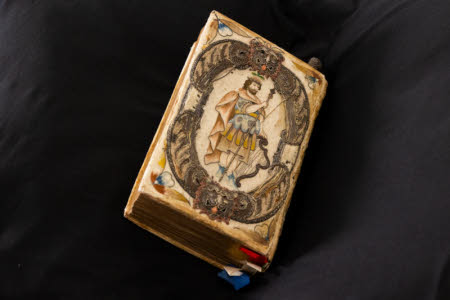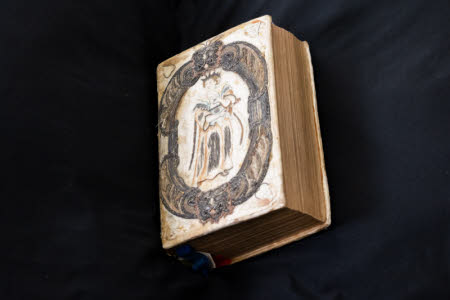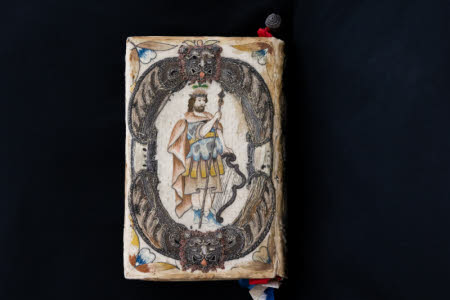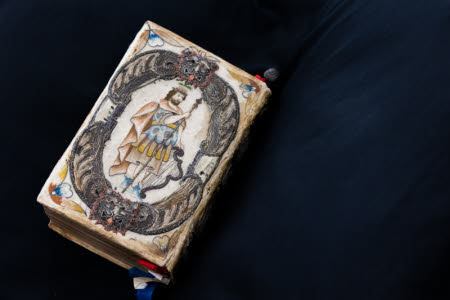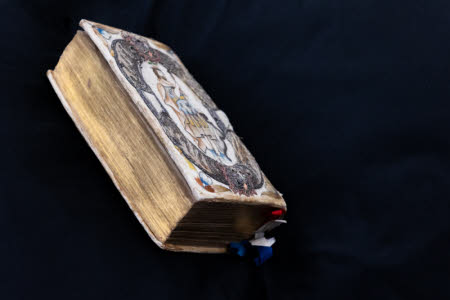The booke of common prayer and administration of the sacraments:. and other rites and ceremonies of the Church of England.
Category
Books
Date
1634 - 1636
Materials
Silk satin, Silk thread, Linen, Wool, Silver gilt thread, Silver thead, Leather thong, Parchment, Paper, Silk ribbon, Glass beads
Measurements
18 x 12.5 x 6 cm
Place of origin
London
Order this imageCollection
Lanhydrock, Cornwall
NT 3245167
Summary
Volume of four pamphlets in an embroidered binding: (1) "The Book of Common Prayer ..." (London, 1635); (2) "The Genealogies: ..." (1635); (3) "The Holy Bible: ..." (London, 1634); (4) "The vvhole book of Psalmes: ..." (London, 1636). Provenance: no marks of provenance. Binding: seventeenth-century cream silk satin over boards on four recessed alum-tawed thongs with parchment strips as spine supports. all over embroidered decoration, an early bookmark of plaited pink threads and a later batten covered in metallic threads with six silk ribbons attached (two each of red, white and blue), gilded edges, and the remains of two pairs of ties under the pastedowns. The decoration comprises: oval cartouches of metal threads (silver and gilt metal) on both covers with the remains of lion's heads at the top and bottom of each cartouche; the cartouches contain the figures of Esther holding a sceptre (front) and David with his harp and spear (back) worked in polychrome silk threads outlined in metal threads; the ground design within the cartouches had small 'dots' of metal purl thread, now virtually all lost.The corners of each cover are decorated with flowers; the spine has been divided into five sections using metal threads, each section contains the remains of a flower. The covers are padded with linen (thick linen threads and some underlying linen fabric) and wool. Due to light damage, the front cover especially has faded over time; the lions' heads have lost most of the beads for eyes (one remains). Extensive historic adhesive treatment and losses to embroidery. Fragile: in a purpose-built buckram box to minimise handling.
Full description
Embroidered bindings are expensive luxury objects, never intended for everyday use. For a long time regarded as the work of amateurs, recent research has established that groups of bindings with similar designs were produced by professional embroiderers for the Stuart Court in the 1620s to 1640s. Although the records of the Worshipful Company of Broderers were destroyed in the Great Fire of London of 1666, payments to embroiderers have been found in royal accounts. This volume of four pamphlets in an elaborate embroidered binding contains: (1) "The Book of Common Prayer ..." (London, 1635); (2) "The Genealogies: ..." (1635); (3) "The Holy Bible: ..." (London, 1634); (4) "The vvhole book of Psalmes: ..." (London, 1636). Bound not long after printing of the final item in 1636 it was covered in luxurious cream silk satin with an all over embroidered decorative scheme containing metal and coloured silk threads. The design includes large oval cartouches, or frames, of expensive silver and gilt metal threads on both covers, surrounded by multi-coloured silk flowers, which also feature on the spine. The oval cartouches contain the Old Testament figures of Esther holding a sceptre (front) and David with his harp and spear (back) which link to the iconography within the contemporary Long Gallery plasterwork ceiling at Lanhydrock. At the top and bottom of each cartouche are the remains of distinctive lions’ head motifs. The lions’ head motifs and the quality of the work link this book to a group of similar bindings made by a high-end workshop which was active in the late 1630s and early 1640s. Most bindings within this group contain two male, or two female figures on their covers; the Lanhydrock binding is unusual in having both female and male figures on the covers. Although there are no signs of ownership either on or within the book, it is thought to have been acquired as new in the late 1630s. It is assumed that the book was bought as a gift by John Robartes (1606-1685) to his first wife Lady Lucy Rich (c. 1615/6-before 1646/7). As staunch Puritans, the Old Testament figures would have been familiar to them and to their family and friends. Small enough to carry to Sunday church services, the embroidery would have been hard to hold. This book may once have been part of a set of embroidered items which included a bag for the book and a pair of gloves or mittens.
Provenance
By descent, until given by Gerald, 7th Viscount Clifden (1883-1966), with the transfer of the house to the National Trust in 1953.
